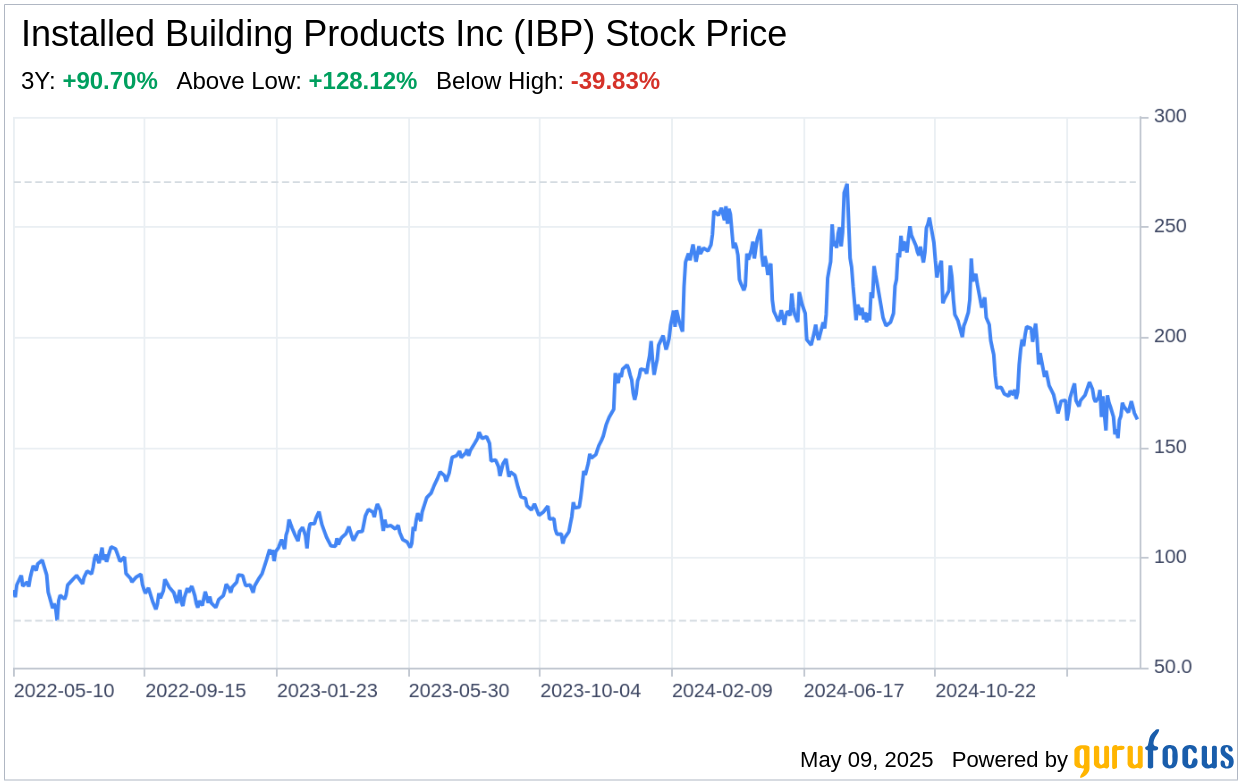Installed Building Products Inc (IBP, Financial), a leading installer of insulation and complementary building products, has released its 10-Q filing on May 8, 2025. The company's financial performance for the first quarter of 2025 shows a slight decrease in net revenue to $684.8 million from $692.9 million in the same period last year. Despite this, IBP maintains a strong liquidity position with $298.7 million in cash and cash equivalents. The company's strategic acquisitions and diverse product offerings across the United States continue to support its market presence. This SWOT analysis delves into the strengths, weaknesses, opportunities, and threats that shape IBP's operational and financial strategies.

Strengths
Robust Financial Health and Liquidity: Installed Building Products Inc (IBP, Financial) has demonstrated financial resilience, evidenced by its substantial cash and cash equivalents totaling $298.7 million as of March 31, 2025. The company's ability to generate cash from operations and maintain a strong liquidity position enables it to invest in growth initiatives, such as strategic acquisitions aimed at expanding its market reach and product portfolio. This financial stability also allows IBP to return capital to shareholders, as seen in the increased dividends and share repurchases totaling $91.6 million during the first quarter of 2025.
Diversified Product and Service Offerings: IBP's comprehensive range of installation services for residential and commercial construction, including insulation, waterproofing, and fireproofing, positions the company as a one-stop-shop for building products. This diversification not only mitigates the risks associated with market fluctuations in any single product category but also enhances cross-selling opportunities. Furthermore, IBP's nationwide network of over 250 branch locations facilitates a broad geographic footprint, ensuring a strong market presence and the ability to serve customers across the United States effectively.
Weaknesses
Revenue and Gross Profit Decline: The recent 10-Q filing reveals a 1.2% decrease in net revenue and a 4.6% decrease in gross profit for the first quarter of 2025 compared to the previous year. This decline reflects challenges in the market, such as reduced installation segment volume and increased material and vehicle costs. While IBP has strategies in place to address these issues, the immediate impact on financial performance highlights the company's vulnerability to market pressures and cost escalations.
Labor Cost and Availability Concerns: As a labor-intensive business, IBP faces challenges related to hiring, training, and retaining skilled installers. The construction industry's tight labor market puts upward pressure on wages and workers' compensation costs, impacting IBP's operating expenses. Although the company has better-than-average employee retention rates due to its strong culture and comprehensive benefits, the additional costs associated with these incentives could offset the productivity gains from improved retention.
Opportunities
Expansion Through Acquisitions: IBP's strategic acquisition plan, which targets companies with at least $100.0 million in aggregate net revenue annually, presents significant growth opportunities. These acquisitions can enhance IBP's market share, extend its geographic reach, and broaden its product and service offerings. The company's strong cash position supports this aggressive acquisition strategy, potentially leading to increased revenue streams and economies of scale.
Favorable Long-Term Market Dynamics: The U.S. residential and commercial construction markets offer long-term growth prospects for IBP. Factors such as demographic trends, an aging housing stock, and the need for energy-efficient insulation solutions drive demand for the company's services. Moreover, IBP's largest customers, publicly traded homebuilders, are employing innovative strategies like mortgage rate buydowns to increase affordability, which could bolster the residential construction market and, in turn, benefit IBP.
Threats
Material Cost Fluctuations: IBP is susceptible to price increases from suppliers, which have been exacerbated by supply shortages and inflationary pressures in recent years. Tariffs on imported goods also pose a risk of further cost escalations. While IBP endeavors to pass these increases onto customers, there is a risk that continued price hikes could compress margins, especially if housing demand contracts and price adjustments become more challenging.
Economic and Industry Volatility: The company's performance is closely tied to the health of the construction industry, which is influenced by economic factors such as interest rates, consumer confidence, and mortgage availability. Any downturn in the economy or the housing market could lead to reduced demand for IBP's services, impacting its revenue and profitability. Additionally, competition within the industry remains intense, requiring IBP to continuously innovate and differentiate its offerings to maintain its competitive edge.
In conclusion, Installed Building Products Inc (IBP, Financial) exhibits a strong financial foundation and strategic positioning within the building products industry. The company's robust liquidity and diversified offerings are key strengths that support its growth trajectory. However, challenges such as revenue declines, labor costs, and material price volatility require vigilant management. Opportunities for expansion through acquisitions and favorable market dynamics present avenues for IBP to enhance its market share. Nevertheless, threats from economic uncertainty and industry competition necessitate a proactive approach to maintain profitability and market leadership. As IBP navigates these dynamics, its strategic initiatives and operational efficiency will be crucial in sustaining long-term success.
This article, generated by GuruFocus, is designed to provide general insights and is not tailored financial advice. Our commentary is rooted in historical data and analyst projections, utilizing an impartial methodology, and is not intended to serve as specific investment guidance. It does not formulate a recommendation to purchase or divest any stock and does not consider individual investment objectives or financial circumstances. Our objective is to deliver long-term, fundamental data-driven analysis. Be aware that our analysis might not incorporate the most recent, price-sensitive company announcements or qualitative information. GuruFocus holds no position in the stocks mentioned herein.
